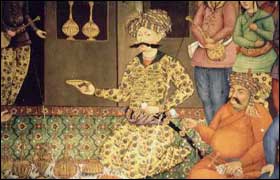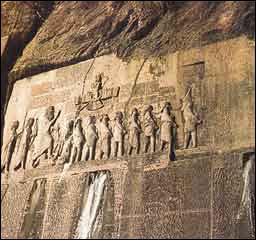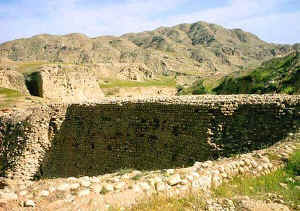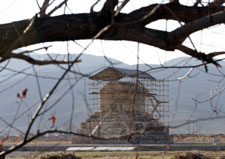|
Shah Abbas Safavi Shah Abbas I: (January 27, 1571-January 19, 1629) was the most eminent ruler of the Safavid Dynasty. He was also known as Shah Abbas the Great. In early October, 1588 he became Shah of Iran, by revolting against his father, Mohammad of Safavid, and imprisoning him. In the midst of general anarchy in Persia, he was proclaimed ruler of Khorasan in 1581, and obtained possession of the Persian throne with the help of Morshed Gholi Ostajlou, whom he later killed in July, 1589. Determined to raise the fallen fortunes of his country, he first directed his efforts against the predatory Uzbeks, who occupied and harassed Khorasan. After a long and severe struggle, he regained Mashhad, defeated them in a great battle near Herat in 1597, and drove them out of his dominions.
Another Dam Construction by the Islamic Regime, Another Crime Against Iranian Heritage Also: Village With Cavemen Discovered at Jiroft Heights Sent by: Amil Imani
Restoration of Cyrus' Tomb Started in Pasargadae CHN
“Studies on the condition of Cyrus’ Tomb and its susceptibility had already started last year, and following that the restoration project of this Achaemenid monument was planned. About 30 years ago, some parts of this monument were restored by an Iranian expert. However, since the material which was used in the restoration was cement, and cement and stone do not stick together for a long time, the cracks appeared once again through which the raindrops leaked into the tomb and caused more damages to the monument. In this restoration project we will try to prevent any water leakage by closing the cracks,” said Mohammad Hassan Talebian, head of Parse-Pasargadae Research Center. The restoration work started with the ceiling of this historical monument and experts believe that the restoration of the ceiling will be completed by the end of winter. “Some stones had been removed during the previous restoration work. This time we also have to remove some giant stones and put them back to their original place. The exact place of the stones will be determined by the metal braces used in the construction of the tomb,” said Hassan Rahsaz, restoration expert and head of restoration team of Cyrus’ Tomb. So far, experts have relocated three stones of the ceiling, weighing more than 2 tons each. “This year we are intending to pay a special attention to the Tomb of Cyrus and Pasargadae historical site. Therefore, for us this year is the year of Pasargadae,” added Talebian. Pasargadae historical site is located 87 kilometer northeast of Persepolis in Fars province of Iran. Pasargadae was an important city during the Achaemenid era (648 BC–330 BC) and was the first capital of the Persian Empire. It was construction by the order of Cyrus the Great around 546 BC but was left uncompleted due to death of Cyrus in a battle in 529-530 BC. The most important monument in Pasargadae is undoubtedly the tomb of Cyrus the Great. It has six broad steps leading to the grave, the chamber of which measures 3.17 meters in length, 2.11 meters in width and 2.11 meters in height and has a low and narrow entrance. Though there are some doubts whether it is actually the tomb of Cyrus or not, Greek historians tell us that Alexander the Great believed it was so. When Alexander looted and destroyed Persepolis, he paid a visit to the tomb of Cyrus. Alexander commanded Aristobulus, one of his warriors to enter the monument. Inside he found a golden bed, a table set with drinking vessels, a gold coffin, some ornaments studded with precious stones and an inscription of the tomb. Thus many Greek and Persian historians account that after Cyrus the Great was killed in the battle, he was brought to this place and was buried there. They also say that his tomb was constructed towards the sunset since he was fond of the unset view during his lifetime. The tomb of Cyrus the Great has witnessed many dramatic events
in the course of the history. After the conquest of Persia by Arabs
in the seventh century AD, Arab armies came upon the tomb planning
to destroy it. However, the talented caretaker of the grave managed
to convince the Arab commander that the tomb was not built to honor
Cyrus but instead housed the mother of King Solomon. This way he
saved it from destruction.
Tomb and Prison of Cyrus the Great Eternalized CHN
“Concurrent with the Cultural Landscape Seminar which was held in Persepolis from 20th of May to 2nd of June 2006, a special meeting was organized by Dr. Ali Mousavi from University of Berkeley in California and some Iranian and foreign archeologists who had previously worked and studied on Pasargadae and Persepolis historical sites such as Dr. Stronach and Dr. Houf, during which they discussed the condition of the prison and tomb of Cyrus the Great and presented a map and 3D plan of these two ancient monuments,” said Dr. Shahriar Adl, archeologists and UNESCO’s counselor in Iran. According to Adl, the monument which is known as the prison of Cyrus is something similar to Zoroaster’s Kaba which is in Naqsh-e Rostam historical site. Only one wall from one side of this prison has remained and the three others have been destroyed over time. This monument was on the verge of collapse; therefore scaffolds were set behind the only remained wall to prevent collapsing of this wall although the metal supports have somehow vulgarized the landscape of this monument, but it was the only way to save the remaining of Cyrus’ jail in shortest time. “In order to strengthen and restore this historical prison, the remained stones should be detached and after strengthening them, we would stick them back together. Of course, this process many cause some harms to the monument. Therefore, to reduce the possible damages to the monument as much as possible, the map and hologram of this monument and the tomb of Cyrus the Great were provided with the support of Iran’s Astronomy Community. This will not only help us in protecting these two unique historical monuments forever, it will also keep a record of the original shape of these two monuments before their restoration so that the next generations would have a chance to see how the monument looked like before restoration process began,” added Adl. Hologram is a laser photograph which makes a picture or image look life-like. The 3D plan of the monument has been provided with maximum precision and delicacy and will give archeologists a chance to observe all the details of this monument with computer. Pasargadae historical site, which is registered in the List of UNESCO’s World Heritage Sites was the first dynastic capital of the Achaemenid Empire, founded by Cyrus the Great, in Pars, homeland of the Persians in the 6th century BC. Social Security background highlights Interesting Info apart form Political Advertisement Part!!!
I received this information from a peer and thought I'd share it with you. History holds all sorts of really interesting facts, but many people forget about them and only think about this moment in time. I try to limit my political diatribes as much as possible, but the misinformation going around today on so many fronts is simply breath-taking to me. A friendly reminder is very important to have around at times, so for what it’s worth.....
|






